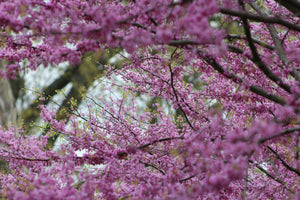Most people in the industry or serious gardeners are keenly aware of the trend toward native plants. I think I might get myself in trouble here, and my youngest son is not going to see this prior to publication. He’s the ultimate governor (thanks, Chase). I endorse, but can’t say I embrace, the trend for natives. I have spent a lifetime in this industry and still remain passionate. A degree in horticulture from good ole Rutgers U., professionally accredited nurseryman for the state of New Jersey, several other accolades and accreditations, but frankly, it seems like I’m boasting. I’m not, just establishing some credibility.
More and more I find myself asking: what is a native? I’m sure I’ll get a gazillion opinions on this. I recently did a tree tip on a redbud cultivar, ‘Northern Lights’. So Cercis canadensis is a true native (redbud).
Does the introduction of a cultivar make it a non-native? So many cultivars of Clethra, Hydrangea arborescens, even blueberry. Cultivars come to market several ways. Oftentimes, it is simply a reversion or sport on a plant that exhibits different characteristics than the original plant. If a plant is selected for flower, shape, disease resistance, etc., I believe a selection should still be considered a native. Keep in mind, these are “Art’s” rules—frankly, just my common-sense approach to life. Maybe there are those who declare “Just the native.” As my dad would say, “I got news for you”—these reversions happen in the wild as well as in the nursery. So I’m sticking with my premise. I think we get a little murky when breeding comes into play.
So many attributes can be bred into plants: flower size, color, fruit, ultimate height and width. Most importantly, disease and insect resistance, and even sterility to prevent invasive species. I could speak specifically about many plants, but would find myself veering off course into non-natives.
Our native redbud achieves a height of 20–25’ or so. What if we wanted a smaller tree? ‘Ace of Hearts’ and ‘Little Woody’ probably struggle to get to 10–12’. Flowers are the same, all the other attributes are similar—it’s simply the size. I believe these were selections, but have not done a deep dive on this.
One of my heroes, Dr. Elwin Orton of Rutgers, spent a lifetime hybridizing plants. The emphasis was on hollies and dogwoods, but there were other genera as well. Our native dogwood is susceptible to a myriad of maladies (English teacher would be proud of me): anthracnose, powdery mildew, borers, and a devastating vascular disease that is attacking redbud, dogwood, and certain maple cultivars, to name a few. This last disease is a serious issue, as there is no reasonable control as of now. I believe it is exacerbated by wet weather.
I applaud the efforts to reduce disease and insect problems in dogwood through crosses of Cornus nuttallii and Kousa, but there is nothing like Cornus florida relative to flowering. The Rutgers hybrids (thanks, Dr. Orton)—i.e., ‘Aurora’, ‘Stellar Pink’, ‘Constellation’, etc.—are solid choices, but the flower just is not the same. The last time I checked, most businesses exist to make a profit. If you are consistently losing half or more of your crop, you have to start thinking twice about growing that crop. I, for one, would hate to see the demise of Cornus florida. So I ask: to preserve a species, is it acceptable to breed disease resistance into Cornus florida so we might continue to grow and enjoy this tree in our respective yards? Or is this not acceptable?
My last point—agree or not. If you could speak with Renoir, Monet, or Michelangelo, and you told them that their palette could only have green and yellow, what type of response might you get? Many of us here have spent a lifetime being truly passionate in the industry. If it’s me, I want the full palette. I do not cast shade (yeah, I’m hip) on anyone who prefers to plant only natives. I truly support this movement, but as I said, I do not embrace it, as I want the entire palette. Sid and Annette Laster would be very disappointed in me if I did not utilize my education and experience to the fullest. We regularly bring in special requests and often carry native plants, so I’m not negative—just like the broader choice. Always wanted to ask the purist: do they eat Wagyu beef, Nordic sardines, or do they eat maize in its original form?
Just a thought.
By most accounts, I offer good information, and as a good friend in the industry once declared, “You’re a great steward of the industry.” I try—and I try to be extremely tolerant of differing opinions. I suppose there might be those who grandstand or strut their stuff, but an opinion (even laced in fact) is still just that. No slight intended to anyone, and if you might need Cornus canadensis (fantastic plant, super difficult to establish), we will make our best effort to find it for you.
Truly appreciate you all,
Art

